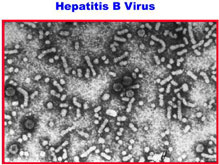 HBF is pleased to connect our blog readers to Christine Kukka’s monthly HBV Journal Review that she writes for the HBV Advocate. The journal presents the
latest in hepatitis B research, treatment, and prevention from recent academic and medical journals. This month, the following topics are explored:
HBF is pleased to connect our blog readers to Christine Kukka’s monthly HBV Journal Review that she writes for the HBV Advocate. The journal presents the
latest in hepatitis B research, treatment, and prevention from recent academic and medical journals. This month, the following topics are explored:
- Health Concerns Grow as Researchers Uncover the Risks of “Occult”
- Are Current Hepatitis B Tests Missing Some Infections?
- First Case of Tenofovir Resistance Found in Patient with Prior Entecavir Resistance
- Even Specialists Fail to Treat Hepatitis in Patients Who Qualify for Treatment
- No Benefit Found from Antiviral Treatment after Liver Cancer Surgery
- Another Study Confirms Success of Sequential Antiviral and Interferon Treatment
- Snapshot of Hepatitis B in the United States
- Metformin Safe and Effective in Cirrhotic Patients with Diabetes Type 2
HBV Journal Review
August 1, 2014
Volume 11, Issue 8
by Christine M. Kukka
Health Concerns Grow as Researchers Uncover the Risks of “Occult” Hepatitis B
Researchers studying the health effects of “occult” hepatitis B are finding that this infection that can “hide” from conventional lab tests carries a higher risk of liver cancer and poses a risk to the general population when undiagnosed.
This type of hepatitis B occurs when a mutation in the virus’ outer coat, made up of the hepatitis B surface antigen (HBsAg), makes it impossible for common lab tests that look for that protein to identify an active HBV infection. The HBsAg lab test is commonly used to identify hepatitis B in patients and even blood supplies.
When lab tests fail to identity HBV infection, people can unknowingly spread the infection to their partners, family members and newborns. And when occult HBV infection goes untreated, a patient’s risk of liver cancer is 3.7-fold higher than in patients with “regular” or non-occult hepatitis B, according to a recent report in the August issue of the Journal of Hepatology.
HBsAg has three proteins and in the case of occult HBV, the immune system attacks one of the three surface proteins–the same protein that lab tests look for when screening blood for HBsAg.
Most vaccines contain this exact same HBsAg protein in order to spur production of surface antibodies to fight off an actual infection. In most cases, the vaccine is very effective, but when occult hepatitis B occurs, the vaccine-induced antibodies are powerless against the remaining two surface proteins and viral reproduction and infection can continue.
This concern has grown recently as scientists find a number of children born to HBV-infected mothers, who were immunized at birth, have developed “occult” hepatitis B. Additionally, people with occult hepatitis B can transmit the mutated, “occult” version of HBV to partners and close contacts (even if they’re vaccinated), adding to the spread of this hard-to-identify viral hepatitis infection.
Because of the unique genetic make-up of this mutated HBsAg and how it interacts with liver cells, this mutation appears to cause more rapid liver damage and cancer.
Scientists suggest that drug resistance, especially to the antiviral lamivudine (Epivir-HBV), may contribute to development of this mutation.
“Recent studies have reported that (surface mutations) tend to (emerge) with the drug resistance-associated mutations in lamivudine-treated patients, and that the (mutations) …. play a supportive role in the replication of lamivudine-resistant viruses,” Italian researchers wrote in the report.
“Therefore it appears of the utmost importance that patients with chronic hepatitis B are screened for the presence of (surface antigen) mutant infection,” they recommended. “The detection of these specific HBV variants may indeed be useful for the identification of those patients requiring a preventive and appropriate treatment and a more intensive follow-up strategy for early detection of liver cancer.”
Source: www.journal-of-hepatology.eu/article/S0168-8278(14)00304-3/fulltext
Are Current Hepatitis B Tests Missing Some Infections?
When do hepatitis B tests miss true infections?A number of confounding factors, ranging from “occult” hepatitis B increase (see above article), failure of lab tests to pick up extremely low levels of HBsAg, immunizations, and the rapidly changing progression of HBV infection can all conspire to mask the infection from conventional laboratory tests.
Read the HBV Journal Review in its entirety
 HBF is pleased to connect our blog readers to Christine Kukka’s monthly HBV Journal Review that she writes for the HBV Advocate. The journal presents the
latest in hepatitis B research, treatment, and prevention from recent academic and medical journals. This month, the following topics are explored:
HBF is pleased to connect our blog readers to Christine Kukka’s monthly HBV Journal Review that she writes for the HBV Advocate. The journal presents the
latest in hepatitis B research, treatment, and prevention from recent academic and medical journals. This month, the following topics are explored:



